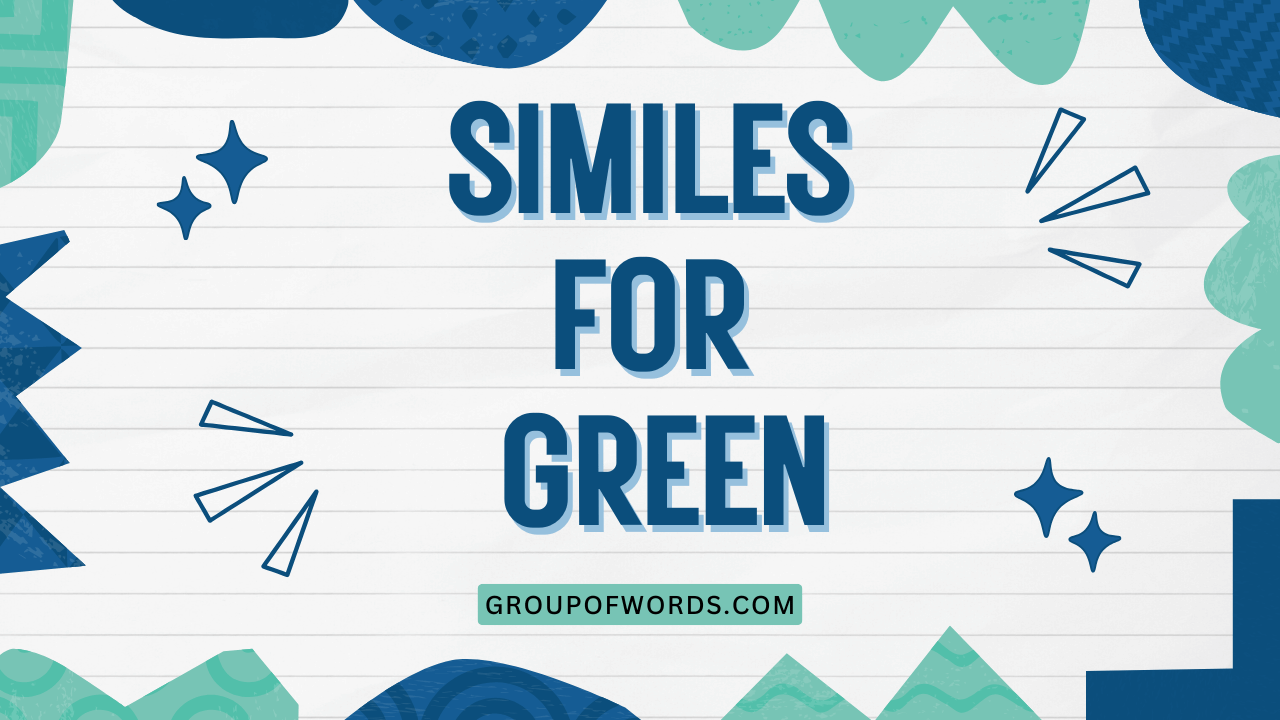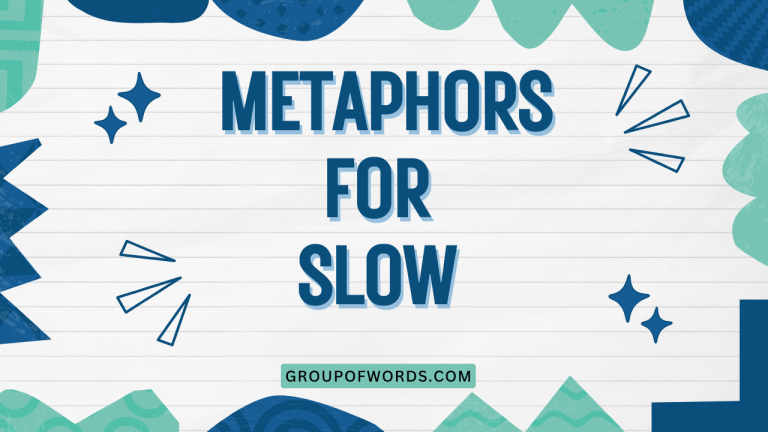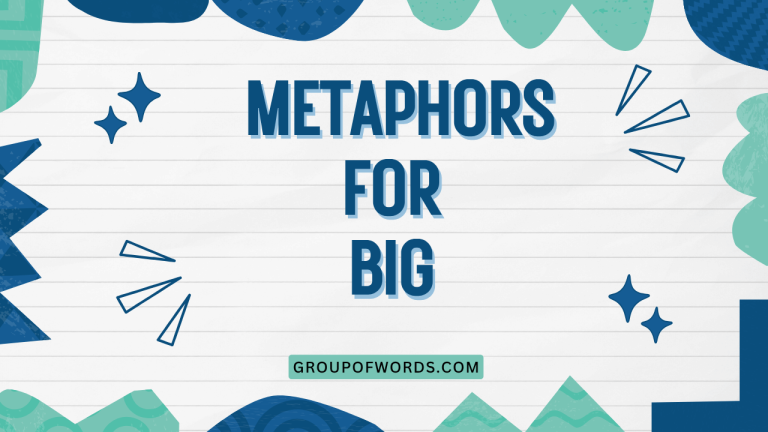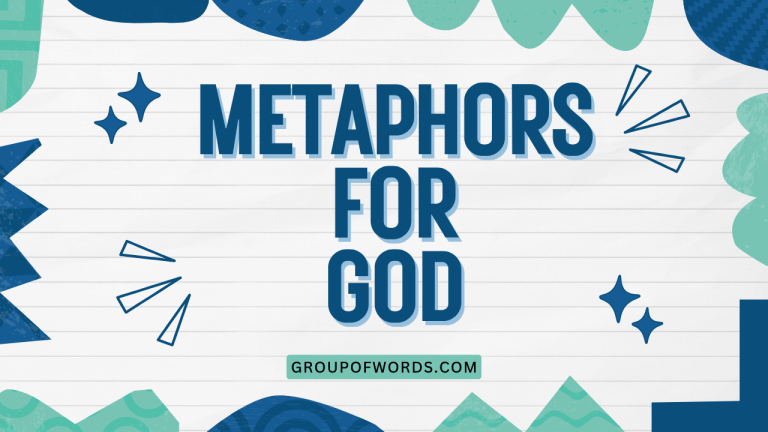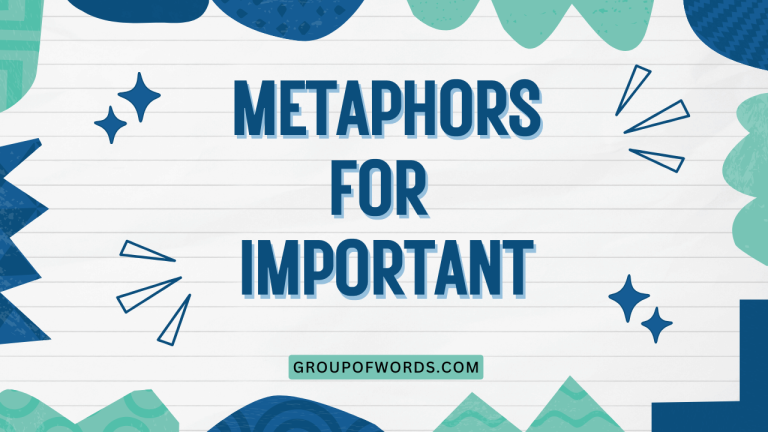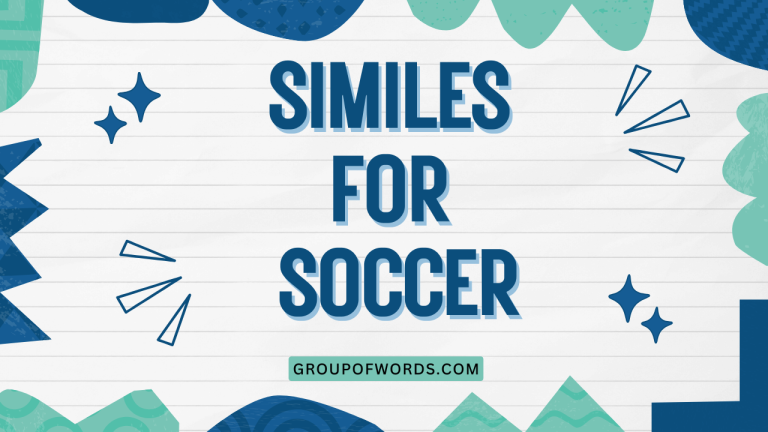Green Similes: A Vivid Guide to Figurative Language
Similes are powerful tools in the English language that allow us to create vivid comparisons and paint pictures with words. Understanding how to use similes effectively can significantly enhance your writing and speaking skills.
This article focuses specifically on similes that use the color green as a point of comparison. Whether you’re a student learning the basics of grammar or a writer looking to enrich your prose, this guide will provide you with a comprehensive understanding of green similes, their structure, usage, and applications.
By exploring a wide range of examples and practical exercises, you’ll learn how to craft compelling similes that evoke the essence of green in all its forms. This deep dive will help you appreciate the nuances of figurative language and master the art of descriptive writing.
Table of Contents
- Introduction
- Definition of a Simile
- Structural Breakdown of Similes
- Types of Similes
- Examples of Green Similes
- Usage Rules for Similes
- Common Mistakes with Similes
- Practice Exercises
- Advanced Topics in Similes
- Frequently Asked Questions
- Conclusion
Definition of a Simile
A simile is a figure of speech that directly compares two different things using the words “like” or “as.” The purpose of a simile is to create a more vivid and descriptive image in the reader’s mind by associating the characteristics of one thing with another. Similes are essential for adding depth, color, and emotion to language.
In essence, a simile is a type of analogy that highlights similarities between two otherwise dissimilar entities. This comparison allows writers and speakers to convey complex ideas or feelings in a more relatable and understandable manner.
By drawing parallels between the known and the unknown, similes enhance clarity and engagement.
Similes are classified as a type of figurative language, meaning they deviate from the literal meaning of words to achieve a specific effect. They function as a tool for creative expression, enabling writers to evoke imagery, convey emotions, and add depth to their narratives.
The context in which a simile is used significantly impacts its effectiveness and interpretation.
Structural Breakdown of Similes
The basic structure of a simile consists of three main components: the subject being described, the linking word (“like” or “as”), and the object to which the subject is being compared. Understanding these components is crucial for constructing effective and meaningful similes.
The subject is the entity that the simile is meant to describe. It can be a person, place, thing, or idea.
The linking word, either “like” or “as,” establishes the comparison between the subject and the object. The object is the entity to which the subject is being compared, chosen for its shared characteristic with the subject.
Let’s break down a green simile example: “The grass is as green as an emerald.” In this example, “the grass” is the subject, “as” is the linking word, and “an emerald” is the object. The simile compares the color of the grass to the color of an emerald, highlighting their shared green hue.
Types of Similes
While all similes share the same basic structure, they can be categorized based on the type of comparison they make or the effect they create. Here are a few common types of similes:
Descriptive Similes
Descriptive similes focus on highlighting the physical characteristics of the subject. They often use sensory details to create a vivid image in the reader’s mind.
Emotional Similes
Emotional similes aim to convey the feelings or emotions associated with the subject. They use comparisons that evoke specific emotional responses in the reader.
Exaggerated Similes
Exaggerated similes, also known as hyperbole, use extreme comparisons to emphasize a particular quality or characteristic of the subject.
Understated Similes
Understated similes, on the other hand, use mild comparisons to downplay or minimize a particular quality or characteristic of the subject. They are often used for ironic or humorous effect.
Examples of Green Similes
The color green evokes a variety of associations, from nature and growth to envy and sickness. This section provides a wide range of examples of similes that use green to create different effects.
Nature-Based Green Similes
Green is strongly associated with nature, growth, and vitality. These similes draw on these associations to describe things that are fresh, vibrant, and alive.
The following table presents a variety of nature-based green similes, illustrating how the color green can be used to evoke images of lush landscapes, thriving plants, and natural beauty. These similes emphasize the freshness, vitality, and growth associated with the natural world.
| Simile | Explanation |
|---|---|
| The leaves were as green as jade. | Compares the color of the leaves to the vibrant green of jade. |
| The grass looked like a carpet of green velvet. | Compares the texture and color of the grass to soft, green velvet. |
| His thumb is as green as a seasoned gardener’s. | Indicates someone has a natural talent for gardening. |
| The forest canopy was like an emerald sea. | Evokes the image of a vast, shimmering green expanse. |
| The new shoots were as green as spring itself. | Connects the color of new growth with the freshness of spring. |
| The algae in the pond was like a slick green blanket. | Describes the algae’s appearance as a covering over the water. |
| The fields stretched out, as green as a golfer’s dream. | Highlights the perfectly manicured green of a golf course. |
| The valley was as green as an untouched paradise. | Suggests a pristine and idyllic natural setting. |
| The moss on the rocks was like a soft green cushion. | Compares the texture and color of moss to a comfortable cushion. |
| The bamboo stalks stood as green as silent sentinels. | Evokes the image of tall, watchful green bamboo. |
| The unripe mangoes hung like green ornaments. | Compares the unripe mangoes to decorative ornaments due to their color. |
| The spinach was as green as a healthy diet. | Associates the color of spinach with the concept of healthy eating. |
| The kale leaves were like dark green flags. | Describes the kale leaves as prominent and bold. |
| The salad was as green as a fresh start. | Connects the freshness of a salad with the idea of a new beginning. |
| The herbs in the garden looked like a green apothecary. | Evokes the image of a garden filled with medicinal green plants. |
| The lettuce was as green as a rabbit’s delight. | Associates the color of lettuce with the pleasure of a rabbit. |
| The green peppers shone like polished gems. | Compares the peppers to precious stones due to their vibrant color and shine. |
| The cucumbers were as green as a summer rain. | Connects the color of cucumbers with the refreshing feeling of summer rain. |
| The limes were like tiny green suns. | Describes the limes as small and bright, resembling miniature suns. |
| The avocado was as green as a creamy dream. | Associates the color of avocado with its smooth and rich texture. |
| The celery stalks stood as green as soldiers in a row. | Compares the celery stalks to uniformed soldiers due to their upright and orderly arrangement. |
| The green beans were like slender emerald ribbons. | Describes the green beans as long, thin, and precious, like emerald ribbons. |
| The zucchini was as green as a garden’s bounty. | Associates the color of zucchini with the abundance of a garden harvest. |
| The peas in the pod were like little green pearls. | Compares the peas to small, precious pearls due to their color and shape. |
| The green grapes hung as green as jewels on the vine. | Describes the green grapes as precious gems hanging from the vine. |
| The kiwi fruit was as green as a tropical secret. | Connects the color of kiwi fruit with the mysterious allure of the tropics. |
| The honeydew melon was like a sphere of pale green sweetness. | Describes the honeydew melon as a round, sweet, and subtly green fruit. |
Envy-Related Green Similes
Green is also associated with envy and jealousy, stemming from the expression “green with envy.” These similes use this association to describe feelings of resentment or longing for what others have.
The following table provides examples of envy-related green similes, illustrating how the color green can be used to depict feelings of jealousy, resentment, and longing. These similes often involve negative emotions and highlight the discomfort associated with envy.
| Simile | Explanation |
|---|---|
| He turned as green as a goblin with envy. | Compares his envy to the sickly green color of a goblin. |
| Her eyes were like green daggers of jealousy. | Describes her jealous gaze as sharp and piercing. |
| He was as green as a moldy fig with resentment. | Associates his resentment with the unpleasant color of mold. |
| She looked as green as poison when she heard the news. | Compares her appearance to the dangerous color of poison. |
| Their faces were as green as bile with spite. | Connects their spiteful expressions with the unpleasant color of bile. |
| He felt as green as a swamp with jealousy. | Evokes the image of a murky, unpleasant swamp to represent his jealousy. |
| She was as green as a witch’s brew with envy. | Compares her envy to the sinister color of a witch’s potion. |
| He looked as green as a sick frog with jealousy. | Connects his jealous appearance with the unhealthy color of a sick frog. |
| She was as green as a jealous monster with rage. | Describes her rage as intense and fueled by jealousy. |
| He turned as green as a venomous snake with envy. | Compares his envy to the dangerous color of a venomous snake. |
| His words dripped as green as venom with envy. | Compares his envious words to toxic venom due to their harmful nature. |
| She watched him, her eyes as green as acid with jealousy. | Describes her jealous gaze as corrosive and destructive, like acid. |
| The room felt as green as a dungeon with envy. | Evokes the image of a dark and oppressive dungeon to represent the feeling of envy. |
| He was as green as a graveyard with resentment. | Associates his resentment with the somber and morbid atmosphere of a graveyard. |
| Her smile was as green as a mask with envy. | Compares her envious smile to a deceptive mask, hiding true feelings. |
| He felt as green as a gargoyle with jealousy. | Evokes the image of a grotesque and watchful gargoyle to represent his jealousy. |
| Her laughter sounded as green as a curse with envy. | Describes her envious laughter as ominous and malevolent, like a curse. |
| He stood there, as green as a ghost with jealousy. | Compares his jealous appearance to the pale and spectral color of a ghost. |
| The silence was as green as a tomb with envy. | Evokes the image of a silent and lifeless tomb to represent the stifling feeling of envy. |
| She harbored a grudge as green as a viper with envy. | Compares her envious grudge to the dangerous and venomous nature of a viper. |
| His ambition burned as green as wildfire with envy. | Compares his envious ambition to a destructive and uncontrollable wildfire. |
| She plotted her revenge, as green as a serpent with envy. | Describes her envious plotting as cunning and treacherous, like a serpent. |
| The air hung as green as a shroud with envy. | Evokes the image of a heavy and suffocating shroud to represent the oppressive feeling of envy. |
| He clutched his success, as green as a miser with envy. | Compares his envious clutching to the possessiveness of a miser. |
| Her dreams twisted as green as thorns with envy. | Describes her envious dreams as painful and sharp, like thorns. |
| He built his empire, as green as a fortress with envy. | Compares his envious empire-building to the imposing and defensive nature of a fortress. |
| The memories lingered, as green as ghosts with envy. | Evokes the image of haunting and persistent ghosts to represent the lingering feeling of envy. |
Sickness-Associated Green Similes
In some contexts, green can be associated with sickness, paleness, or nausea. These similes use this association to describe someone who is feeling unwell or looks ill.
The following table presents sickness-associated green similes, illustrating how the color green can be used to depict feelings of nausea, illness, and general unwellness. These similes often involve descriptions of physical discomfort and a lack of vitality.
| Simile | Explanation |
|---|---|
| He looked as green as sea-sick sailor. | Compares his pale complexion to that of someone suffering from seasickness. |
| Her face was like a green mask of nausea. | Describes her nauseous expression as a pale, green mask. |
| He felt as green as old cheese after the rollercoaster. | Associates his feeling of sickness with the unpleasant color of old cheese. |
| She turned as green as a ghost with the flu. | Compares her pale appearance to that of a ghost due to the flu. |
| He looked as green as a zombie after the all-nighter. | Connects his exhausted appearance with the unhealthy color of a zombie. |
| She was as green as a wilted leaf with exhaustion. | Evokes the image of a faded, lifeless leaf to represent her exhaustion. |
| He felt as green as a swamp creature with illness. | Compares his sickly feeling to the unpleasantness of a swamp creature. |
| She looked as green as a moldy wall with sickness. | Associates her unhealthy appearance with the unpleasant color of mold. |
| He was as green as a poisoned apple with nausea. | Compares his nauseous appearance to the dangerous color of a poisoned apple. |
| She turned as green as a sickly plant with fever. | Connects her feverish appearance with the unhealthy color of a sickly plant. |
| His skin was as green as parchment with illness. | Compares his pale and sickly skin to the color of old parchment. |
| She felt as green as a dying ember with weakness. | Evokes the image of a fading ember to represent her extreme weakness. |
| He looked as green as a faded photograph with fatigue. | Associates his tired appearance with the faded color of an old photograph. |
| She was as green as a stagnant pond with sickness. | Compares her unhealthy appearance to the murky color of a stagnant pond. |
| He felt as green as a rotting log with nausea. | Associates his nauseous feeling with the unpleasant color of a rotting log. |
| She looked as green as a pale moon with illness. | Compares her pale and sickly appearance to the color of a pale moon. |
| He was as green as a shadow with exhaustion. | Evokes the image of a dark shadow to represent his extreme exhaustion. |
| She felt as green as a ghost ship with sickness. | Compares her sickly feeling to the eerie presence of a ghost ship. |
| He looked as green as a tombstone with nausea. | Associates his nauseous appearance with the somber color of a tombstone. |
| She was as green as a forgotten grave with illness. | Compares her unhealthy appearance to the neglected state of a forgotten grave. |
| His energy drained as green as a leaking battery with sickness. | Compares his depleting energy to a leaking battery due to his sickness. |
| She tried to smile, but it was as green as a grimace with nausea. | Associates her forced smile with the unpleasant color of a grimace due to her nausea. |
| He moved as green as a marionette with sickness. | Compares his stiff and unnatural movements to a marionette due to his sickness. |
| She spoke as green as a whisper with illness. | Compares her faint voice to a whisper due to her illness. |
| He breathed as green as a sigh with exhaustion. | Associates his heavy breath with a sigh due to his extreme exhaustion. |
| She lay as green as death with fever. | Compares her lifeless appearance to the color of death due to her fever. |
| His thoughts swirled as green as fog with sickness. | Associates his confused thoughts with the disorienting nature of fog due to his sickness. |
Object-Based Green Similes
Green similes can also be based on specific objects known for their green color. These similes add specificity and clarity to the comparison.
The following table provides examples of object-based green similes, illustrating how specific green objects can be used to create vivid and descriptive comparisons. These similes often enhance clarity and add a unique touch to the imagery.
| Simile | Explanation |
|---|---|
| The car was as green as a race car. | Compares the car’s color to the bright green often seen on race cars. |
| Her dress was like a green emerald. | Compares the dress’s color to the precious gemstone emerald. |
| The paint was as green as a traffic light. | Associates the paint’s color with the distinct green of a traffic light. |
| The toy was as green as a plastic army man. | Compares the toy’s color to the green plastic of toy soldiers. |
| The fabric was like a green billiard table. | Describes the fabric’s color and texture as similar to a billiard table. |
| The book cover was as green as a vintage encyclopedia. | Connects the book cover’s color with the classic green of old encyclopedias. |
| The sign was as green as a highway marker. | Compares the sign’s color to the distinctive green of highway markers. |
| The balloon was like a green gumdrop. | Describes the balloon’s color and shape as similar to a green gumdrop. |
| The glass was as green as a wine bottle. | Associates the glass’s color with the green tint of wine bottles. |
| The stone was as green as a peridot. | Compares the stone’s color to the gemstone peridot. |
| The raincoat was as green as an army tent. | Compares the raincoat’s color to the durable green of an army tent. |
| The backpack was like a green hiking pack. | Describes the backpack’s color and style as similar to a green hiking pack. |
| The blanket was as green as a felt board. | Associates the blanket’s color with the green felt of a board. |
| The rug was as green as an AstroTurf. | Compares the rug’s color to the artificial green of AstroTurf. |
| The vase was like a green sea glass. | Describes the vase’s color and texture as similar to sea glass. |
| The ribbon was as green as a satin sash. | Connects the ribbon’s color with the elegant green of a satin sash. |
| The light was as green as a laser pointer. | Compares the light’s color to the bright green of a laser pointer. |
| The marker was like a green highlighter. | Describes the marker’s color as similar to a green highlighter. |
| The tape was as green as duct tape. | Associates the tape’s color with the common green of duct tape. |
| The shirt was as green as a polo shirt. | Compares the shirt’s color to the classic green often found in polo shirts. |
| The umbrella was as green as a patio umbrella. | Compares the umbrella’s color to the shade of a patio umbrella. |
| The wallet was like a green leather billfold. | Describes the wallet’s color and material as a green leather billfold. |
| The notebook was as green as a composition book. | Associates the notebook’s color with the standard green of a composition book. |
| The folder was as green as a manila folder. | Compares the folder’s color to the common green of a manila folder. |
| The case was like a green carrying case. | Describes the case’s color as a green carrying case. |
| The toy car was as green as a die-cast model. | Connects the toy car’s color with the green of a die-cast model. |
| The chair was as green as a folding chair. | Compares the chair’s color to the green of a folding chair. |
Usage Rules for Similes
Using similes effectively requires attention to detail and a clear understanding of the rules that govern their usage. Here are some key rules to keep in mind:
- Ensure Clarity: The comparison should be clear and easily understood by the reader. Avoid obscure or confusing comparisons.
- Maintain Relevance: The object of comparison should share a relevant characteristic with the subject. The comparison should make sense in the given context.
- Avoid Clichés: Try to avoid overused similes that have lost their impact. Aim for originality and creativity in your comparisons.
- Consider Tone: The simile should match the overall tone and style of your writing. Avoid using humorous similes in a serious context, and vice versa.
- Use sparingly: Overusing similes can make your writing seem forced or artificial. Use them judiciously to enhance your writing, not overwhelm it.
Common Mistakes with Similes
Even experienced writers can make mistakes when using similes. Here are some common errors to avoid:
| Incorrect | Correct | Explanation |
|---|---|---|
| The grass is green like a color. | The grass is as green as an emerald. | The object of comparison should be specific and evocative. |
| He was green with envy as a feeling. | He was as green as a goblin with envy. | The comparison should be to a tangible or relatable object or entity. |
| She looked green like sick. | She looked as green as a ghost with the flu. | The comparison should be more descriptive and detailed. |
| The leaves are green like the green. | The leaves are as green as jade. | Avoid redundant comparisons that state the obvious. |
| The car was green as car. | The car was as green as a race car. | Ensure the comparison provides additional information or imagery. |
Practice Exercises
Test your understanding of green similes with these practice exercises.
Exercise 1: Identify the Simile
Identify the simile in each of the following sentences:
| Question | Answer |
|---|---|
| 1. The garden was as green as a jungle. | as green as a jungle |
| 2. He was green with envy when she won the prize. | green with envy |
| 3. The paint was a vibrant shade of green. | (No simile) |
| 4. Her eyes were like green gemstones. | like green gemstones |
| 5. The lime tasted green and sour. | (No simile) |
| 6. The moss felt as green as a soft blanket. | as green as a soft blanket |
| 7. The fields stretched out, green and endless. | (No simile) |
| 8. He looked as green as a sick frog. | as green as a sick frog |
| 9. The valley was green and peaceful. | (No simile) |
| 10. She was as green as poison when she heard the news. | as green as poison |
Exercise 2: Complete the Simile
Complete the following similes using appropriate comparisons:
| Question | Answer |
|---|---|
| 1. The leaves were as green as __________. | jade |
| 2. He was as green as __________ with envy. | a goblin |
| 3. Her face was like a green __________ of nausea. | mask |
| 4. The grass looked like a carpet of green __________. | velvet |
| 5. She turned as green as __________ with the flu. | a ghost |
| 6. The algae in the pond was like a slick green __________. | blanket |
| 7. He felt as green as __________ after the rollercoaster. | old cheese |
| 8. She was as green as a jealous __________. | monster |
| 9. The cucumbers were as green as __________. | summer rain |
| 10. The celery stalks stood as green as __________ in a row. | soldiers |
Exercise 3: Create Your Own Similes
Create your own green similes based on the following prompts:
- Describe a lush forest using a green simile.
- Describe the feeling of envy using a green simile.
- Describe someone who is feeling sick using a green simile.
- Describe a garden in the spring using a green simile.
- Describe a vibrant green object using a green simile.
Advanced Topics in Similes
For advanced learners, exploring the nuances of similes can lead to a deeper appreciation of figurative language. Consider these advanced topics:
- Extended Similes: Similes that are developed over multiple sentences or paragraphs, creating a more complex and detailed comparison.
- Subverted Similes: Similes that intentionally break the rules or expectations of traditional comparisons, often for humorous or ironic effect.
- Similes in Poetry: Analyzing how similes are used in poetry to create imagery, evoke emotions, and enhance the overall meaning of the poem.
- Similes in Different Cultures: Exploring how similes vary across different languages and cultures, reflecting different perspectives and values.
Frequently Asked Questions
- What is the difference between a simile and a metaphor?
A simile directly compares two things using “like” or “as,” while a metaphor implies a comparison without using those words. A simile says something is *like* something else, while a metaphor says something *is* something else. For example, “He is as brave as a lion” (simile) vs. “He is a lion” (metaphor).
- Can a simile be too obvious or cliché?
Yes, overused similes can lose their impact and make your writing seem unoriginal. It’s best to avoid clichés and strive for fresh, creative comparisons.
- How can I make my similes more effective?
Use specific and evocative language, choose objects of comparison that share relevant characteristics with the subject, and consider the overall tone and style of your writing.
- Is it okay to use similes in formal writing?
While similes are more common in creative writing, they can be used in formal writing if they enhance clarity and understanding. However, avoid overly flowery or emotional similes in formal contexts.
- How many similes should I use in a piece of writing?
Use similes sparingly to enhance your writing without overwhelming it. The number of similes depends on the length and style of your piece, but it’s generally best to avoid overuse.
- What if I can’t think of a good simile?
Don’t force it! Sometimes, a direct description is better than a weak simile. You can also brainstorm by thinking about the characteristics of the thing you’re trying to describe and then listing things that share those characteristics.
- Are similes only used in writing?
No, similes are also used in spoken language to make descriptions more vivid and engaging. They can be a powerful tool for communication in both written and oral contexts.
- Can I use a simile to compare two abstract concepts?
Yes, you can compare abstract concepts using similes, but it’s important to make the comparison clear and relatable. Choose objects of comparison that have tangible qualities that can help the reader understand the abstract concepts.
Conclusion
Mastering the art of using similes, especially those involving the color green, can significantly enhance your ability to create vivid and engaging descriptions. By understanding the structure, types, and usage rules of similes, you can effectively use them to add depth, color, and emotion to your writing and speaking.
Remember to practice regularly and pay attention to the similes used by other writers and speakers. By analyzing and imitating effective similes, you can develop your own unique style and voice.
Don’t be afraid to experiment with different comparisons and explore the full range of possibilities that similes offer.
Ultimately, the key to using similes effectively is to be creative, thoughtful, and attentive to the nuances of language. With practice and dedication, you can become a master of figurative language and unlock the full potential of your
language skills.
